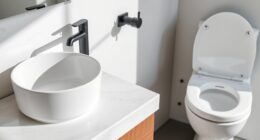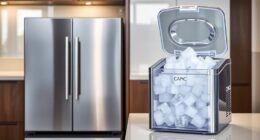When selecting from the 13 best solar-compatible inverter chargers of 2025, I focus on models that offer high power capacity, efficient energy conversion, and versatile operation modes like hybrid, grid, or solar priority. I look for robust safety features, multiple charging options, and real-time monitoring tools to guarantee reliability. Size, weight, and installation ease also matter. Keep reading to uncover detailed insights and find the perfect match for your off-grid setup.
Key Takeaways
- Ensure the inverter charger supports high solar input capacity (up to 4000W) and MPPT technology for optimal energy harvesting.
- Prioritize models with multiple operation modes, safety protections, and compatibility with various battery chemistries and voltages.
- Look for units with user-friendly monitoring, remote control, and real-time system management features.
- Consider size, weight, cooling, and installation options suitable for your off-grid or mobile setup.
- Choose inverters with high efficiency (>90%), surge capacity up to 6000W, and certifications like UL or CE for reliable, safe performance.
3000W Power Inverter 12V DC to 110V AC with USB and Remote

If you’re looking for a reliable inverter to power your devices during emergencies or on the road, the 0W Power Inverter 12V DC to 110V AC with USB and Remote stands out. It delivers a continuous 3000W of power, peaking at 6000W, perfect for running appliances like TVs, laptops, or even small kitchen devices. It connects directly to your vehicle or solar system’s 12V battery, ensuring versatile use. With dual USB ports and a remote control, it offers convenience and flexibility. Built with safety features like overload and overheating protection, plus quiet cooling fans, this inverter is designed for durability and reliable performance in various scenarios.
Best For: users needing high-capacity portable power solutions for emergencies, camping, or mobile work sites to run multiple appliances and electronics reliably.
Pros:
- Delivers a robust 3000W continuous power with peak 6000W, suitable for heavy-duty appliances and tools.
- Equipped with safety features including overvoltage, undervoltage, overload, short circuit, and overheating protections.
- Features dual USB ports, remote control, and quiet cooling fans for convenience, safety, and low noise operation.
Cons:
- Some users have reported overheating and wire heating issues if not used properly or if the unit is overburdened.
- Size and weight (15.4 x 7.6 x 3.3 inches; 8.3 pounds) may be less portable for certain applications.
- Higher price point compared to smaller or less powerful inverters, which may not be suitable for all budgets.
3500W Pure Sine Wave Inverter with Transfer Switch
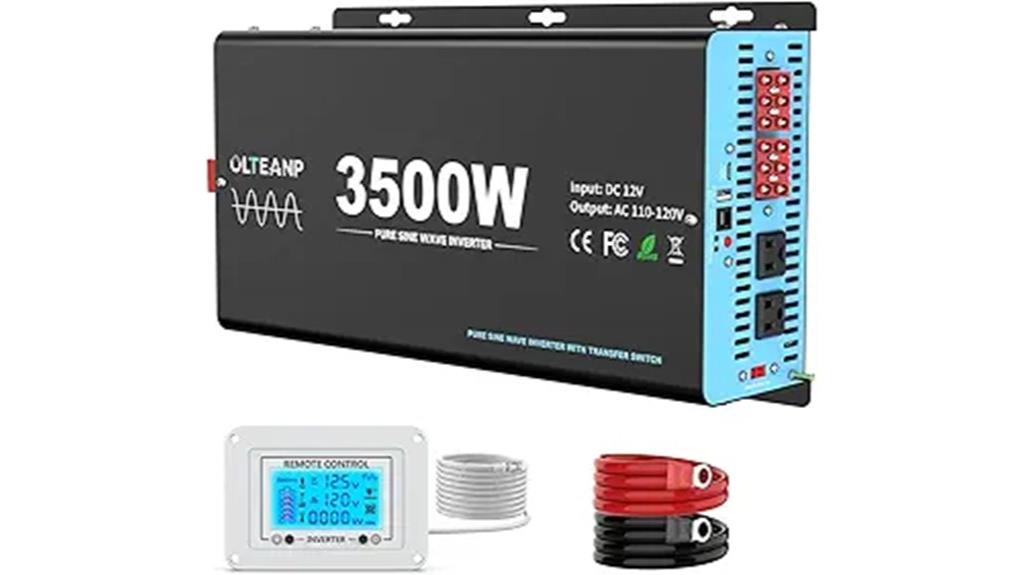
The 0W Pure Sine Wave Inverter with Transfer Switch is an excellent choice for those who need reliable, seamless power backup in remote or off-grid situations. It delivers 3500W continuous power with a peak of 7000W, ensuring stable, clean energy for sensitive electronics and appliances like laptops, TVs, and freezers. Its automatic transfer switch instantly switches between main power and backup, providing uninterrupted operation. Equipped with a remote control and LCD display, it’s easy to monitor and manage. Safety features like spark-free circuits protect your gear, while multiple outlets and USB ports support versatile device charging. This inverter guarantees dependable, efficient power wherever you need it.
Best For: individuals seeking reliable, clean power backup for sensitive electronics and appliances in remote, off-grid, or emergency situations.
Pros:
- Provides stable, pure sine wave power suitable for delicate devices like laptops and medical equipment
- Features automatic transfer switch for seamless switching between main and backup power sources
- Includes multiple outlets and USB ports for versatile charging options
Cons:
- May be relatively heavy and bulky for portable use
- Higher cost compared to standard inverters without transfer switch features
- Requires proper installation and setup to ensure optimal safety and performance
LiTime 24V 3000W All-in-One Solar Inverter Charger
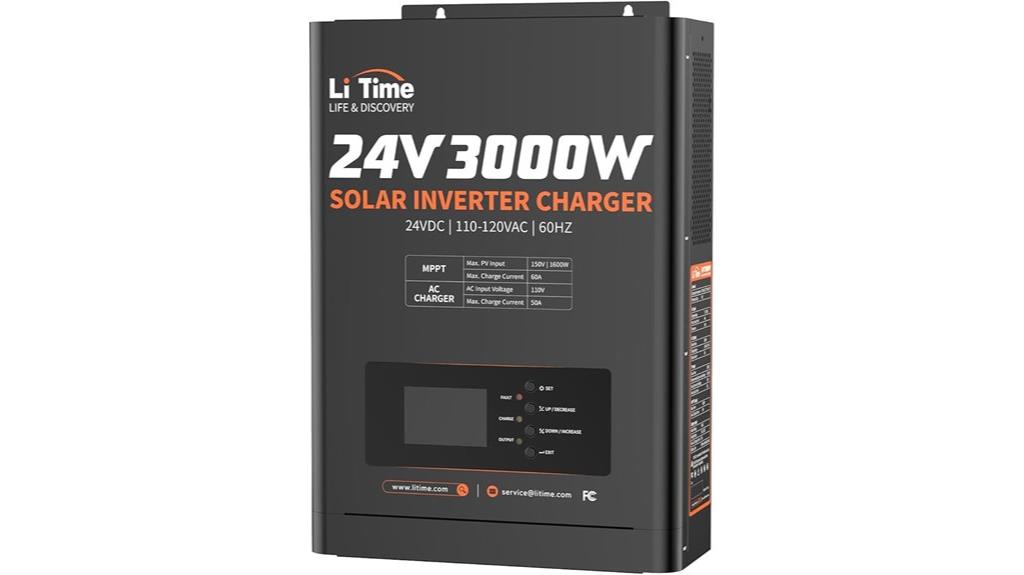
The LiTime 24V 3000W All-in-One Solar Inverter Charger stands out for its integrated MPPT solar controller, inverter, and charger, making it an excellent choice for those setting up a reliable off-grid power system. It supports a surge of up to 9000W and delivers pure sine wave power, ensuring stable energy. Its multiple modes—MPPT First, Grid First, and Inverter First—offer flexibility, with seamless switching between sources. Compatible with 24V lead-acid or lithium batteries, it features an LCD display, LED indicators, and RS485 communication for system monitoring. Overall, it combines efficiency, versatility, and user-friendly operation for off-grid and home energy storage needs.
Best For: homeowners and off-grid enthusiasts seeking a reliable, integrated solar inverter charger for energy storage and backup power.
Pros:
- Integrates MPPT controller, inverter, and charger in one unit for streamlined setup
- Supports high surge power of up to 9000W with pure sine wave output for stable energy supply
- Compatible with both lead-acid and lithium batteries, featuring user-friendly LCD and communication options
Cons:
- Standby power consumption of approximately 45W may impact energy efficiency
- Some users find the integrated battery monitoring limited, requiring external solutions for accurate SOC readings
- The on/off switch may have durability issues, potentially affecting long-term reliability
3000W DC 24V Pure Sine Wave Inverter with Solar Charger

For those seeking a reliable and efficient power solution, the 0W DC 24V Pure Sine Wave Inverter with Solar Charger stands out due to its high compatibility with 24V solar systems and versatile charging options. It features a 3000W pure sine wave inverter integrated with an 80A MPPT solar charger, supporting multiple battery types like lithium, AGM, and Gel. Its four charging modes—AC Priority, Solar Priority, Only Solar, and Mains & Solar Hybrid—offer flexibility for various setups. The inverter’s LCD display, optional WiFi monitoring, and lightweight design make it a solid choice for home backup, RVs, and off-grid solar systems.
Best For: individuals or businesses seeking a versatile, reliable, and efficient 24V solar power system with integrated inverter and charging capabilities for home backup, RVs, or off-grid applications.
Pros:
- Supports multiple battery types including lithium, AGM, and Gel, offering flexibility for different setups
- Integrated all-in-one design with inverter, MPPT solar charger, and AC battery charger simplifies system integration
- Features LCD display and optional WiFi monitoring for convenient remote system management
Cons:
- Complex parameter setup may require online research and technical knowledge
- WiFi monitoring feature is costly and requires proprietary modules, limiting compatibility with generic devices
- Series connection of solar panels needed due to voltage range can cause shading issues and single points of failure
Y&H 3000W Solar Hybrid Inverter (DC24V to AC230V)
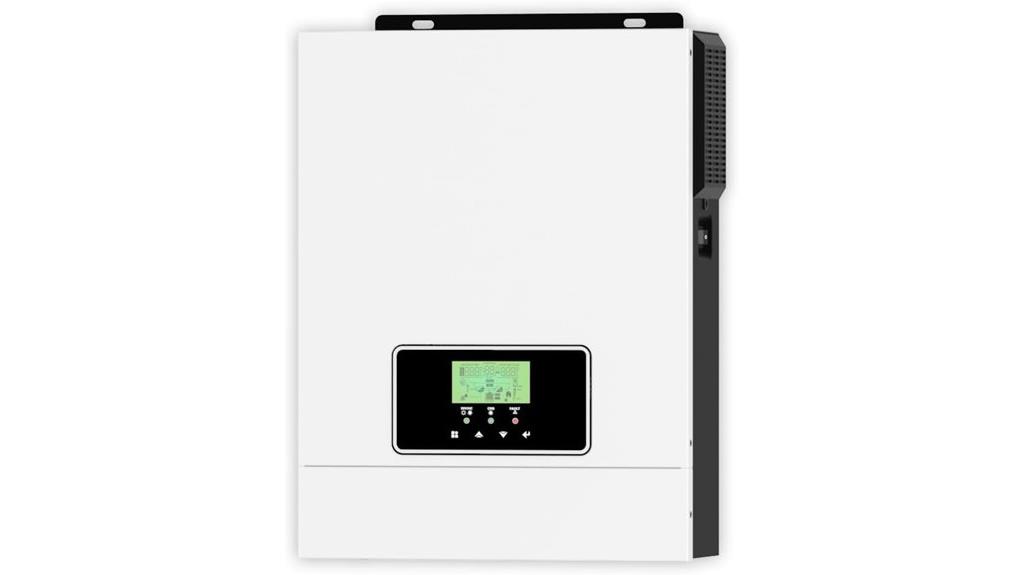
If you’re looking for an efficient and versatile hybrid inverter, the Y&H 3000W Solar Hybrid Inverter stands out with its pure sine wave output and flexible charging options. It converts 24V DC to 230V AC, supporting household and outdoor applications like RVs, boats, and emergencies. Its built-in 80A MPPT solar charger maximizes solar energy use, and it supports multiple batteries, including lead-acid and lithium types. With a surge capacity of 6000W and four charging modes, it ensures reliable power management. The LCD display and remote monitoring make system status easy to track, making this inverter a solid choice for off-grid power solutions.
Best For: individuals seeking a reliable, versatile hybrid inverter for off-grid applications such as RVs, boats, or emergency backup at home.
Pros:
- Pure sine wave output ensures safe and efficient operation of sensitive electronics
- Supports multiple battery types, including lead-acid and lithium, for flexible energy storage
- Built-in 80A MPPT solar charger maximizes solar energy utilization for higher efficiency
Cons:
- Fan noise (50-70 dB) may disrupt rest if installed near sleeping areas
- Requires a transformer for US 110/120V devices, which is not included
- Relatively heavy at 14 pounds, which may impact portability and installation options
3000 Watt Pure Sine Wave Inverter for RV, Solar, Home

A 3000-watt pure sine wave inverter delivers clean, reliable power perfect for RV living, solar setups, or home backup systems. With over 91% efficiency and a 6000W surge capacity, it handles sensitive electronics like laptops, CPAPs, and LEDs effortlessly. Its multiple outlets—including three AC and USB ports—offer versatile connections for devices and high-current appliances. Built with safety in mind, it features protections against overvoltage, overload, and short circuits, plus a durable metal shell that withstands vibrations and surges. The included battery cables and remote monitor make operation straightforward, ensuring your off-grid or emergency power needs are met with confidence and reliability.
Best For: RV owners, solar energy enthusiasts, and home backup users seeking reliable, clean power for sensitive electronics and heavy-duty appliances.
Pros:
- High power capacity with 3000W continuous and 6000W surge, supporting heavy loads and startup demands.
- Multiple outlets including AC, USB, and PD ports provide versatile device compatibility.
- Robust safety features and durable metal shell ensure long-term reliable operation in various environments.
Cons:
- May be heavier and bulkier due to rugged construction and full metal shell.
- Requires proper installation and understanding of electrical connections for safe use.
- Higher upfront cost compared to smaller or less feature-rich inverters.
3000W Inverter with USB and Remote Controller
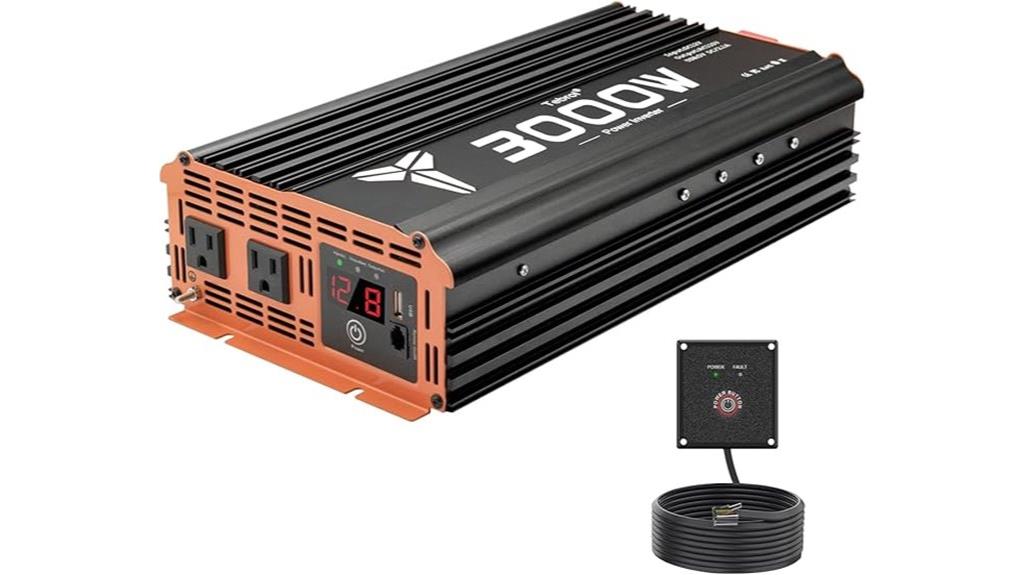
The 3000W inverter with USB and remote controller stands out as an excellent choice for users seeking a powerful, user-friendly solution to keep their devices running during outages or on the go. It delivers 3000W of continuous power, with a peak of 6000W, converting 12V DC from batteries or solar setups to 110V AC. Equipped with multiple safety features—overvoltage, undervoltage, overload, short circuit, and overheating protections—it guarantees safe operation. The soft start technology prevents surges, while dual cooling fans maintain ideal temperature. The remote control and LCD display offer convenient monitoring and operation, making it ideal for camping, emergencies, or mobile power needs.
Best For: outdoor enthusiasts, emergency preparedness, and mobile power users needing reliable, high-capacity inverter solutions.
Pros:
- Provides high continuous power of 3000W with peak capacity of 6000W, suitable for heavy appliances.
- Equipped with comprehensive safety features including overvoltage, undervoltage, overload, short circuit, and overheating protections.
- Comes with remote control and LCD display for easy monitoring and operation, enhancing user convenience.
Cons:
- Requires proper matching of device starting and rated power to avoid overloading.
- May produce noise from dual cooling fans during operation.
- Limited to 12V DC input, necessitating compatible batteries or solar systems for power source.
3000W Hybrid Inverter with MPPT Controller

For those seeking a versatile hybrid inverter capable of seamlessly integrating solar and grid power, the 0W Hybrid Inverter with MPPT Controller is an excellent choice. It converts 24V DC to 110V/120V AC and features an 80A MPPT solar charge controller supporting up to 4000W of PV input, with a high open-circuit voltage of 500V DC. It supports multiple operation modes, including grid priority, solar priority, and battery backup. Its robust protection features, real-time LCD monitoring, and flexible charging options make it ideal for off-grid setups, RVs, or emergency backup, ensuring reliable power with maximum efficiency.
Best For: those seeking a reliable, versatile hybrid inverter for off-grid, RV, camping, or emergency backup power solutions with solar and grid integration.
Pros:
- Supports multiple operation modes including grid priority, solar priority, and battery backup for flexible power management
- Equipped with an 80A MPPT solar charge controller supporting up to 4000W PV input for high efficiency solar charging
- Features real-time LCD display and multiple safety protections to ensure reliable and safe operation
Cons:
- Weight of 17.11 pounds may be less portable for some applications
- Requires a minimum photovoltaic voltage of 130V DC for battery-free operation, limiting certain setups
- Limited to 24V DC input, which may necessitate additional components for different battery systems
Renogy 3000W Pure Sine Wave Inverter with Remote

If you’re seeking a reliable inverter that can handle high-power appliances in off-grid, RV, or marine setups, the Renogy 3000W Pure Sine Wave Inverter with Remote stands out thanks to its impressive 3000W continuous power output and peak surge of 6000W. It converts 12V DC to 120V AC efficiently, supporting various battery types like LiFePO4 and AGM. It handles inductive loads smoothly, with noise minimized below 1130W. Features include multiple outlets, USB port, remote control, and safety protections such as GFCI and overload indicators. Certified UL and CSA, it’s a dependable choice for powering appliances like freezers, TVs, and induction cooktops in demanding off-grid environments.
Best For: off-grid, RV, marine, and camper users needing reliable high-power inverter performance for appliances and inductive loads.
Pros:
- High continuous power output of 3000W with a surge capacity of 6000W, suitable for demanding appliances
- Supports multiple battery types including LiFePO4 and AGM, with efficient conversion exceeding 90%
- Features safety protections like GFCI, overload indicators, and a remote control for convenient operation
Cons:
- Included cables may be undersized, requiring users to upgrade wiring for safety and performance
- Some users experience high-pitched squeals above 1100W load, which can be disruptive
- Higher price point with recent increases may impact affordability for budget-conscious buyers
VEVOR 3000W Pure Sine Wave Inverter Charger

Designed for those seeking reliable backup power or off-grid solutions, the VEVOR 3000W Pure Sine Wave Inverter Charger stands out with its seamless integration of multiple operational modes and extensive safety protections. It converts 24V DC to 120V AC, powering devices like refrigerators and medical equipment reliably. With five modes—such as Grid Priority and Energy-Saving—it adapts to various needs, from RV camping to home backup. Its compatibility with different battery types, including LiFePO4 and lead-acid, offers flexibility. The remote control and monitoring features make management easy, while protections against overloads, short circuits, and temperature issues guarantee safety and equipment longevity.
Best For: individuals and families seeking reliable off-grid power solutions, RV travelers, boat owners, or backup power users requiring stable and versatile energy supply for sensitive devices.
Pros:
- Supports five operational modes for versatile application scenarios
- Compatible with multiple battery types including LiFePO4 and lead-acid batteries
- Includes remote control and monitoring for convenient operation from a distance
Cons:
- Weighs relatively heavy at 44.3 pounds, which may affect portability
- Limited to a recommended load per outlet below 1.2KW, possibly restricting high-power devices
- Customer rating of 4.0/5 indicates some users may experience issues or dissatisfaction
3000W Pure Sine Wave Inverter with USB-C and Quick Charging

The 3000W Pure Sine Wave Inverter with USB-C and Quick Charging stands out as an ideal choice for anyone needing reliable, high-capacity power on the go. It delivers continuous 3000W power with a peak of 6000W during startup, ensuring your devices run smoothly. With over 90% efficiency, it minimizes energy waste. The inverter features six safety protections, including over-voltage and short circuit, safeguarding your appliances. Its pure sine wave output provides stable, deformation-free power suitable for sensitive electronics. Multiple outlets, including USB-C PD30W and QC3.0 ports, allow quick charging of devices, making it perfect for camping, emergency backup, or off-grid living.
Best For: RV owners, off-grid solar users, and portable power users seeking reliable, high-capacity, clean power for sensitive devices.
Pros:
- Provides stable 3000W continuous power with surge capability up to 6000W, suitable for demanding devices.
- Over 90% efficiency minimizes energy waste and prolongs battery life.
- Multiple safety protections and pure sine wave output ensure safe operation and protect sensitive electronics.
Cons:
- Relatively heavy and bulky, which may affect portability.
- Requires proper installation and ventilation due to heat generation, despite silent fan operation.
- Limited to 12V DC input, so compatible with specific battery setups; may need additional adapters for different systems.
ECO-WORTHY 3000W 12V Pure Sine Wave Inverter Charger
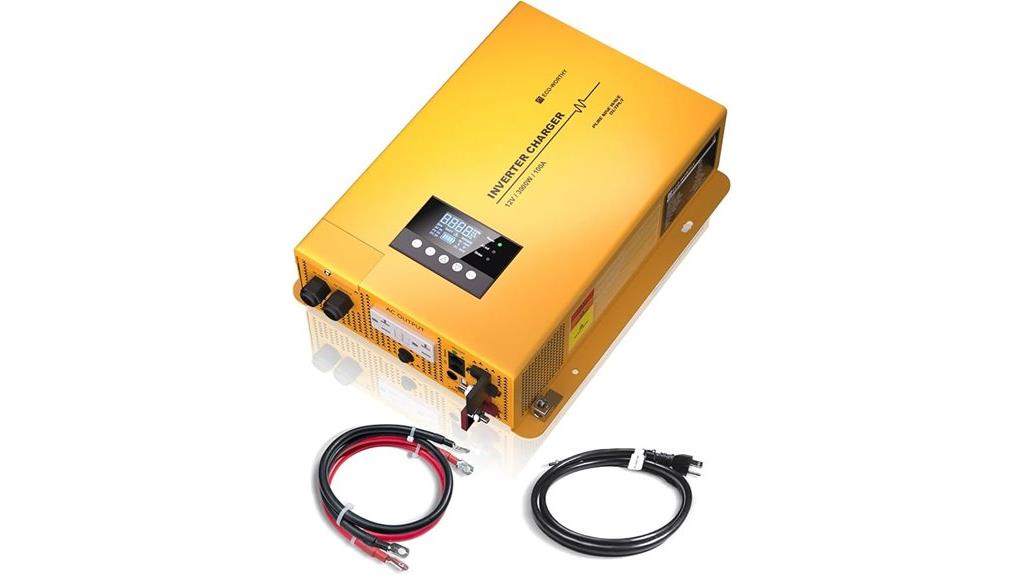
For anyone seeking a durable and versatile inverter charger that can handle heavy appliances, the ECO-WORTHY 3000W 12V Pure Sine Wave Inverter Charger is an excellent choice. It combines 3000W continuous power with a peak capacity of 6000W, making it suitable for appliances like microwaves, refrigerators, and air conditioners. Its adjustable battery charger supports various batteries, including LiFePO4, GEL, and AGM, with built-in safety protections such as overvoltage and short-circuit. The unit features UPS backup, automatic mode switching, and optional remote monitoring. Compact and lightweight, it’s designed for off-grid, RV, marine, and backup power applications, offering reliable performance and value.
Best For: RV owners, off-grid enthusiasts, and backup power users seeking reliable, heavy-duty inverter charger for appliances and critical systems.
Pros:
- Combines high continuous power (3000W) and surge capacity (6000W) suitable for demanding appliances
- Supports multiple battery types including LiFePO4, GEL, and AGM with safety features like overvoltage and short-circuit protection
- Features UPS backup, automatic mode switching, and optional remote monitoring for convenience and reliability
Cons:
- Lacks built-in Bluetooth or communication modules, requiring third-party solutions for remote control
- Some initial setup adjustments needed for LiFePO4 batteries, as default settings are not optimized out of the box
- Slightly heavier and larger than basic inverters, which may impact portability and installation flexibility
Y&H 3200W Solar Hybrid Inverter with MPPT Solar Charger

If you’re seeking a reliable off-grid inverter that combines high power capacity with versatile charging options, the Y&H 3200W Solar Hybrid Inverter with MPPT Solar Charger stands out as an excellent choice. It converts 24V DC to pure sine wave AC, supporting both lead-acid and lithium batteries. With a maximum PV input of 3000W, it’s ideal for RVs, camping, boats, and emergency use. It offers flexible charging modes—solar, mains, or hybrid—and features a built-in MPPT controller for efficient solar harvesting. Its LCD display and remote monitoring make system management straightforward, ensuring you stay powered reliably in off-grid situations.
Best For: off-grid enthusiasts, RV owners, and emergency preparedness users seeking a powerful, versatile inverter for reliable solar and battery-powered applications.
Pros:
- Supports both lead-acid and lithium batteries with multiple charging modes for flexible energy management.
- Equipped with an 80A MPPT solar charge controller for high-efficiency solar harvesting and a maximum PV input of 3000W.
- Features an LCD display and remote monitoring options for easy system oversight and configuration.
Cons:
- Not compatible with 120V AC output directly; additional converters are necessary for US standard appliances.
- Noise levels of 50-70 dB may be disruptive if installed near bedrooms or quiet environments.
- Does not support parallel or split-phase operation in some regions, limiting scalability in certain setups.
Factors to Consider When Choosing a Solar Compatible Inverter Charger 3000W

When selecting a 3000W inverter charger, I focus on key factors like power capacity and surge ability to handle peak loads. Compatibility with my batteries and the available charging modes also matter to guarantee seamless integration and efficiency. Additionally, safety features and ease of installation are vital for reliable, hassle-free operation.
Power Capacity and Surge
Choosing a 3000W inverter charger requires careful attention to its power capacity and surge capabilities. It must provide at least 3000W of continuous power to meet your load demands reliably. Additionally, verify that its surge capacity can handle short-term peak loads—typically 1.5 to 2 times the continuous rating—meaning around 4500W to 6000W for a 3000W inverter. This is vital for starting high-inrush appliances like refrigerators or air conditioners without tripping or damage. Make sure the inverter’s surge capacity aligns with these requirements and can sustain peak power long enough to start heavy loads. Finally, ensure the inverter’s capacity matches or exceeds the total wattage of all connected devices to prevent overloads and ensure smooth operation.
Compatibility With Batteries
Matching your inverter charger to your battery bank is key to guaranteeing reliable and safe operation. I always check that the inverter supports my battery chemistry, whether it’s lead-acid, lithium-ion, or LiFePO4, to optimize performance and safety. It’s also vital to verify that the voltage and capacity ratings align with my battery bank’s specs—like 12V, 24V, or 48V—to avoid overload or underperformance. I look for models with built-in or compatible Battery Management Systems (BMS) to protect lithium batteries and extend their lifespan. Additionally, I ensure the inverter’s charging current and power output match my batteries’ recommended charging rates. Some inverters support multiple battery types or adjustable settings, giving me flexibility as my system evolves.
Charging Modes Offered
Selecting the right charging modes for a 3000W solar-compatible inverter charger is essential to maximize efficiency and protect your batteries. These modes, like MPPT Solar Priority, Grid Priority, and Hybrid, determine whether the inverter prioritizes solar power, the grid, or both. This choice affects how well your system utilizes available energy sources and extends battery life. Many models also allow you to adjust charging currents, such as from 20A to 80A, ensuring compatibility with your battery capacity and avoiding overcharging. Some inverters include specialized modes like “Inverter First” or “Grid First,” providing seamless power transfer during outages or fluctuations. Understanding these options helps you optimize system performance based on your energy needs and setup, ensuring reliable and efficient off-grid operation.
Safety and Protection
Safety and protection features are essential when evaluating a 3000W solar-compatible inverter charger because they guarantee reliable operation and safeguard your equipment. I look for models with extensive protections like overvoltage, undervoltage, overload, short circuit, and over-temperature safeguards to prevent damage. Automatic shutdown or alarm features are important, as they alert me to faults before any harm occurs. Ground-fault circuit interrupters (GFCI) or similar grounding protections are necessary for preventing electrical shocks and ensuring safety. Additionally, I verify that the inverter complies with safety certifications such as UL, CE, or FCC, which confirm it meets recognized safety standards. Built-in cooling systems like fans or heat sinks are also significant, helping prevent overheating during continuous use and maintaining safe operating temperatures.
Ease of Installation
When choosing a 3000W solar-compatible inverter charger, ease of installation is a critical factor that can save you time and prevent frustration. I look for models that come with clear, thorough instructions to guarantee proper setup without guesswork. It’s important that the inverter supports compatible mounting options and has dimensions that fit my available space comfortably. Plug-and-play connections or minimal wiring are ideal, as they simplify the process and reduce installation errors. Accessible connection points for batteries, AC input/output, and solar input with straightforward wiring make setup quicker and more manageable. Additionally, built-in safety protections and user-friendly interfaces help with initial configuration and ongoing operation, giving me confidence in the system’s reliability and ease of use.
Monitoring and Control
Since monitoring and control are essential for keeping my solar system running smoothly, I prioritize inverter chargers that offer real-time data and easy access to system performance. Features like LCD displays, LED indicators, or remote control capabilities help me quickly identify issues and track energy flow. Remote monitoring options such as WiFi, GPRS, or RS485 allow me to oversee and adjust settings from anywhere, boosting convenience. User-friendly control panels enable me to configure charging modes, load priorities, and system parameters without hassle. Compatibility with external monitoring apps provides detailed insights into battery health, voltage levels, and energy usage. Effective monitoring and control are crucial for safety, optimizing performance, and extending the lifespan of both the inverter charger and my batteries.
Frequently Asked Questions
How Do Inverter Chargers Handle Extended Power Outages?
Inverter chargers are great during extended power outages because they automatically switch to battery power, keeping your systems running smoothly. They can handle prolonged outages by efficiently managing energy from your batteries and solar panels, if available. I’ve found that choosing a high-capacity inverter charger guarantees continuous power supply, even during long outages. It’s reassuring knowing my system can keep working without interruption, no matter how long the power’s out.
What Maintenance Is Required for Long-Term Inverter Charger Performance?
I regularly check my inverter charger’s connections and keep it clean to prevent dust buildup. I also make certain the cooling fans are working properly and monitor battery health, as it affects performance. It’s essential to update the firmware when needed and avoid overloads. These simple steps help me maintain reliable, long-term performance, so my system stays efficient and ready whenever I need it.
Can Inverter Chargers Be Expanded for Higher Power Needs?
Yes, inverter chargers can be expanded for higher power needs. I’ve found that many models support modular setups, allowing me to add extra units or connect parallel inverters to increase capacity. This flexibility helps me adapt my system as my power demands grow, guaranteeing I stay powered efficiently. Just keep in mind, checking compatibility and proper configuration is essential to ensure seamless expansion and peak performance.
Are There Specific Certifications to Look for in Solar Inverter Chargers?
When choosing a solar inverter charger, I always check for certifications like UL, IEC, or CSA. These guarantee the device meets safety and quality standards. Certifications give me confidence in the product’s reliability and compliance with electrical codes. I also look for certifications specific to solar applications, like IEEE or IEC 61727, to make sure it’s compatible with solar systems and safe for off-grid use.
How Do Inverter Chargers Manage Battery Aging and Efficiency?
Inverter chargers manage battery aging and efficiency by implementing smart charging algorithms that optimize charge cycles, reducing strain on the batteries. They monitor battery health continuously, adjusting charging rates to prevent overcharging and deep discharging. I’ve found that regular maintenance and using inverter chargers with advanced battery management features help extend battery lifespan and keep efficiency high, ensuring your off-grid system runs smoothly and reliably for years to come.
Conclusion
Choosing the right solar-compatible inverter charger is like finding a trusted partner for your off-grid journey. With the right balance of power, efficiency, and features, you can confidently harness the sun’s energy and power your life. Remember, it’s not just about equipment—it’s about empowering your freedom and future. Let these top options light your path, and step boldly into a sustainable, brighter tomorrow. The power to change your life is within your reach.






